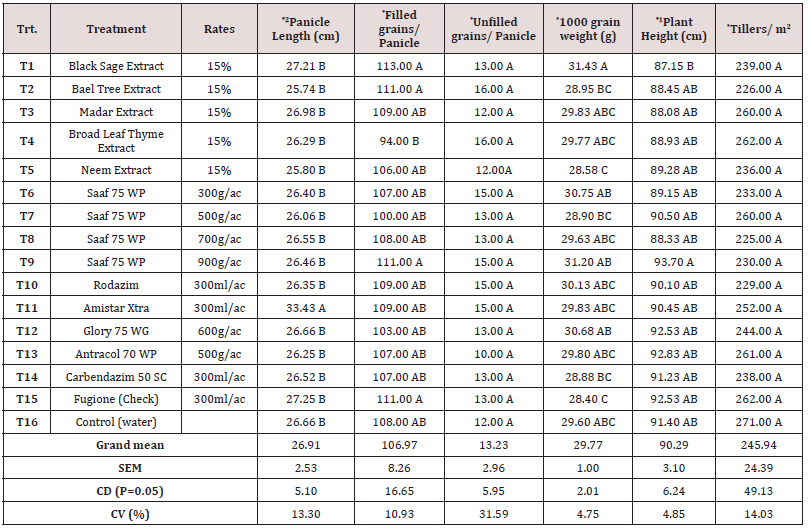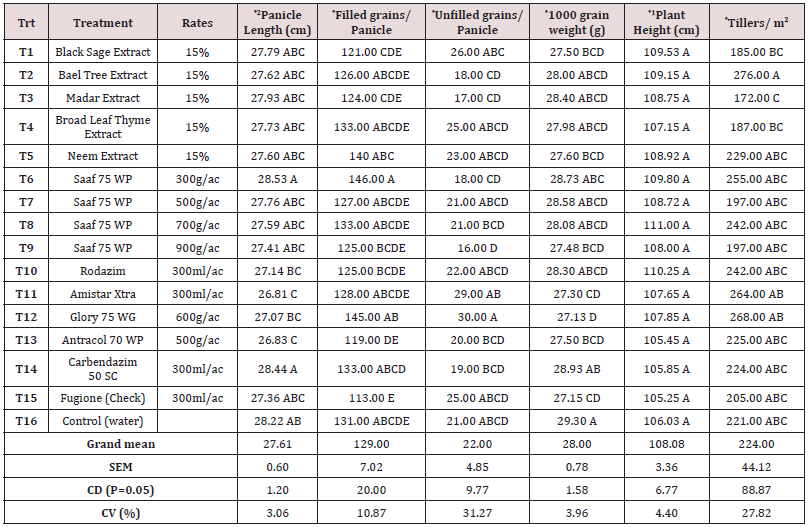
Lupine Publishers Group
Lupine Publishers
Menu
ISSN: 2637-4676
Research Article(ISSN: 2637-4676) 
Management of Rice Grain Discoloration Complex with The Use of Medicinal Plant Extracts and New Generation Fungicides Under Guyana Agricultural Settings Volume 10 - Issue 1
Rajendra Persaud1*, Ghansham Payman1, Narita Singh2, Darshanie Angela Persaud3, Ayub Khan4 and Gomathinayagam Subramanian5
- 1Guyana Rice Development Board (GRDB), Rice Research Station (RRS), Burma, Mahaicony, East Coast Demerara, Guyana
- 2School of Allied Health, University of Guyana, Turkeyen Campus, Greater Georgetown, Guyana
- 3The Faculty of Earth and Environmental Sciences, Department of Environmental Studies, University of Guyana, Turkeyen Campus, Greater Georgetown, Guyana
- 4Faculty of Science and Technology, The University of the West Indies, St. Augustine, Trinidad and Tobago
- 5Faculty of Agriculture and Forestry, University of Guyana, Berbice Campus, Tain, Guyana
Received: August 03, 2022; Published: August 12, 2022
Corresponding author: Rajendra Persaud, Guyana Rice Development Board (GRDB), Rice Research Station (RRS), Burma, Mahaicony, East Coast Demerara, Guyana Email : rajpersaud25@yahoo.com /rpersaud@grdb.gy
DOI: 10.32474/CIACR.2022.10.000329
Abstract
Rice Grain Discolouration (GD) is caused by a complex group of microorganisms. It is an emerging condition capable of causing significant reduction in the quality and quantity of paddy produce in Guyana. The symptoms of GD were observed on all the popular rice cultivar cultivated by the Guyanese farmers. The higher incidence of GD was reported by rice farmers, millers, exporters and other stakeholder in the rice industry in Guyana, may be due to the rapid changes in the climatic conditions, thereby resulted in the increasing of the aggressiveness of the once minor pathogen(s) to devastate the rice industry. During the investigation, management of the GD condition was the main focus using aqueous extracts of medicinal plant and new generation type of fungicides to reduce the disease condition from affecting rice production in the country. The research found treatment with extracts of Black sage plant (Cordia curassavica) at 15%; Bael tree (Aegle marmelos) at 15%; Madar plant (Calotropis gigantea, C. procera) at 15%; Thick leaf thyme (Thymus vulgaris) at 15% and Neem (Azadirachta indica) at 15% along fungicidal treatment with Saaf 75WP (Mancozem 63%, Carbendazim 12%) at 300 to 500, g/ac., Rodazim 50SC (Carbendazim 50%) at 300 ml/ac., Glory 75WG (Mancozeb + Azoxystrobin) at 600g/ac., Antracol 70WP (Propineb) at 500g/ac, Carbendazim 50SC (Carbendazim 50%) at 300 ml/ac. and Fugi One (Isoprothiolane 40% SC) at 300 ml/ac. demonstrated significant reduction in grain discolouration incidence ranging from 33.54 to 75.06 percent during the spring and autumn seasons of 2020 and 2021. Additionally, these treatments showed favorable influence in terms of plant growth, yield parameters and grain yield responses. Therefore, these treatment at their respective rates of application can be recommended as a protective treatment for managing the GD conditions.
Keywords: Rice; Grain Discolouration; Medicinal plant extracts; Fungicides; Management
Introduction
Rice (Oryza sativa L.) is an important cereal crop cultivated in many parts of the world [1]. It is one of the largest users of agri cultural land in Guyana with more that 92,000 ha. being double cropped annually with an average productivity lay between 5.7 to 6.5 t/ha within the different geographical area. Rice contributes more than 22.5% to Guyana agricultural GDP and employment for more than 12% of the Guyanese population directly and indirectly [2]. The rice crop is known to be challenged by many pests and disease. Rice Grain Discoloration (GD) has been one of them that have be on the increase in recent times not only in Guyana, but at a global level causing great reduction in quality and quantity of grains produced [3]. The GD condition was reported by more that 30% of the rice farmers and 75% of the rice millers and exporters [4]. This GD condition have been observed to be on an increase in some of the most popular cultivars under cultivation in Guyana like the GRDB 10, 11, 12, 13, 14 and 15 [5]. This grain discoloration condition often referred to by farmers and millers as ‘black-tip’. It is a dark, small imperfection that occurs on the dorsal surface (the surface opposite the germ) of rice kernels and has a lesion-like appearance that is unlikely to be detected in the field [4,5]. This grain discoloration condition usually causes the grade of paddy to be lowered, resulted in great losses to the farmers. The GD condition is caused by a pathogen complex and was reported from few places of India [6]. Similar observations were reported by many researchers in many other parts of the world where rice have been cultivated [3,4] [7]. reported that eight pathogens namely Bipolaris oryzae, Alternaria alternata, Alternaria padwickii, Drechslera oryzae, Fusarium moniliforme, Curvularia oryzae, Nigrospora oryzae and Aspergillus niger were isolated from seed samples with grain discolouration diseased collected from rice areas of NIAB, Faisalabad, Sheikhupura, Samundri, PirMahal and Vehari [8]. reported that the field fungi such as Drechslera oryzae, Curvularia lunata and Fusarium moniliforme were predominantly associated with the grain discolouration in rice. Likewise, in Guyana [4]. reported that Curvularia spp. to be the most predominant fungal pathogen associated with greater than 95% of the sample observed with signs and symptoms of grain discolouration. Additionally, the presence of Bipolaris oryzae, Sarocladium oryzae, Alternaria spp., Aspergillus spp. and Fusarium spp. was were detected at low levels below 5% of the samples. Subsequently the Centre for Agriculture and Biosciences International (CABI) of the UK has confirmed the pathogen as Curvularia lunata, based on the amplification and sequence analysis of Internal Transcribed Spacer (ITS) region of the rDNA. As such, this experiment was design with the aims to find the most effective management options for the grain discolouration (‘black-tip’) condition within the rice industry in Guyana. In view of this, five plant extracts with anti- microbial properties and seven novel fungicides were evaluated against the pathogens causing grain discolouration under Guyana rice cultivation system.
Material And Methods
Preparation of plant extracts
Healthy and fresh medicinal plants samples of five different plants species viz. Black sage plant (Cordia curassavica); Bael tree (Aegle marmelos); Madar plant (Calotropis gigantea, C. procera); Thick leaf thyme (Thymus vulgaris) and Neem (Azadirachta indica) were collected from surrounding areas of the GRDB, RRS, Burma in region number 5 (Mahaica-Abary), Guyana. These plant samples collected were carefully labelled and transferred to the Laboratory of Plant Pathology Department, RRS, Burma. The plant samples were washed with running tap water and then rinsed two times with sterile distilled water and left in the preparation area to air dry for 2 to 3 hours. The selected plant parts were cut into small pieces (1-3 cm) and 1,000 gram of plant tissue mixed 1,000 ml sterile distilled water (1:1 W/V) was then ground using a heavy duty electrical commercial laboratory blender. The ground samples were filtered through a double layered white muslin cloth into a beaker. The filtrate that constituted 100% concentration was collected and stored in a sterile conical flask at 25-28ºC for further use in the study (13).
Isolation of the grain discolouration microorganism complex
Paddy samples with and without grain discolouration symptoms were collected randomly from farmers’ fields surrounding the GRDB, RRS at Burma in region # 5 (Mahaica-Berbice) and taken to the Laboratory of the Plant Pathology department at GRDB, RRS, Burma. The samples collected were analyzed using the blotter test and agar plate method as described in (14) and (15). The standard protocol of International Seed Testing Association (16) and International Rice Research Institute (IRRI) was followed to detect and identify signs of fruiting bodies of the fungal microorganism complex. The isolation of the microorganism of interest (C. lunata, B. oryzae, S. oryzae, Fusarium sp., Alternaria sp., Aspergillus sp.) was done following the procedure as describe by [4]. The microorganisms complex of interest was identified using temporary microscopic slides prepared from mycelium/ spores emerged from the seeds plated into PDA prepared petri plates. The spores observed were further isolated using single spore isolation technique. The pathogenicity test was carried out following the Koch’s postulates following the protocol as describe by [4]. The most aggressive isolates of the pathogens were mass multiplied and stored at - 4°C for use as inoculum in the current study.
Application of plant extracts and fungicides treatment under in vivo
Individual treatments of plant extracts viz. Black sage plant (Cordia curassavica); Bael tree (Aegle marmelos); Madar plant (Calotropis gigantea, C. procera); Thick leaf thyme (Thymus vulgaris) and Neem (Azadirachta indica) each at 15% concentration and each new fungicides treatment viz. Saaf 75WP (Mancozem 63%, Carbendazim 12%) at 300, 500, 700 and 900 g/ac., Rodazim 50SC (Carbendazim 50%) at 300 ml/ac., Amistar Xtra 28SC (Triazol, Estrobilurtina., Cyproconazol, Azoxystrobin) at 300 ml/ ac., Glory 75WG (Mancozeb + Azoxystrobin) at 600g/ac., Antracol 70WP (Propineb) at 500g/ac, Carbendazim 50SC (Carbendazim 50%) at 300 ml/ac. and Fugi One (Isoprothiolane 40% SC) at 300 ml/ac were keenly calculated, weight/measured out and applied as foliar spray using Cooper Pegler (CP3) manual operated knapsack sprayer with a built in pressure relief valve at 62 and 70 Days After Sowing (DAS). The plots that did not receive plant extract or fungicides serves as untreated control. The uniform spray was ensured by covering both surface of entire plant with minute droplets of the solution.
Field evaluation of plant extracts and fungicides against grain discoloration complex
Field experiments was conducted during the first (spring) crop and second(autumn) crop of 2020 and repeated both season of [5]. Plant Pathology experimental area at the RRS, Burma, Mahaicony, East Coast Demerara. The rice cultivars GRDB 10, GRDB 14 and GRDB 15 were used in this study. The field design laid out using Randomized Complete Block Design (RCBD), with four replications per each treatment as in 2.3. The crop was raised by direct seeded method using a seed rate of 180 lbs/ ac. with an individual plot size of 3 m X 5 m (15 m2). The fertilizer was applied at the rate of N120 P50 K10 Kg/ha at recommended stages of crop growth. The standard agronomic practices were followed throughout the cropping period. The experiment was inoculated with microorganism complex of interest [predominantly Curvularia lunata at 95% concentration level and the others between 3-5% of the spore concentration] with spore suspension concentration of 105 grown in the laboratory at 45, 50 and 55 DAS. The treatments were applied 7 days after inoculation. These treatments were applied as foliar spray two times at an interval of 7-10 days. The control was also sprayed with distilled water.
Assessment of growth parameters, yield attributes, grain yield and grain discoloration incidence
The impact of treatments on growth parameters was assessed by measuring the plant height and counting the number of tillers per square meter at harvesting time. The yield attributes were derived by measuring the panicle length, counting the number of filled and unfilled grains per panicle, weight the 1000-grain from 10 panicles harvested from each individual plots. The total grain yield was assessed after harvest by threshing and recording the weight and moisture from each plot. From the assessment of the grain discolouration incidence the panicle harvested from each plot 100 grains were selected randomly and shelled manually, as well as 100 grams from the samples harvested was weighed and shelled to assessed the percent grain discoloration incidence.
Statistical data analysis and computations
The data obtained from various field experiments were analyzed using the RCBD statistical methods. The ANOVA and statistical significance were obtained using the Statistix 8.0 analytical software and graphs were derived using Microsoft Excel Software, Windows 10. Also, percent change in grain discoloration incidence, growth parameters, yield parameters over control were calculated using the following formula: Percent change= (T-C/C)*100; Where C= Value of control, T= Value of treatment.
Results
Efficacy of plant extracts and fungicides against grain discolouration incidence-2020
During the two cropping seasons of 2020 five (5) medicinal plant extracts and seven (7) fungicides were evaluated at various rates for their effectiveness against grain discolouration (GD). In the spring crop, 2020 all treatment showed significantly lower percent incidence of grain discolouration as compared to the untreated control (Table 1). Treatments with extract from Madar plant (15%) and Neem (15%) showed greater that 45.00 percent reduction in incidence of grain discolouration, followed by Black sage and Bale tree extracts (42.01 and 41.73% reduction in GD incidence, respectively). Similarly, treatment with Carbendazim 50 SC at 300ml/ac; Saaf 75WP at 300 and 500g/ac showed greater than 42% reduction in GD incidence (Table 1). Likewise, during the autumn crop 2020 all treatment application demonstrated significantly lower percent incidence of grain discolouration, with reduction in incidence of grain discolouration ranging from 35.39 to 60.07 percent over the untreated control (Table 1). The highest percentage incidence of grain discolouration was observed to be that of the control during both seasons (16.50% and 15.73%, respectively (Table 1).
Table 1: Effect of plant extracts and fungicides on the incidence of grain discolouration during spring and autumn, 2020.
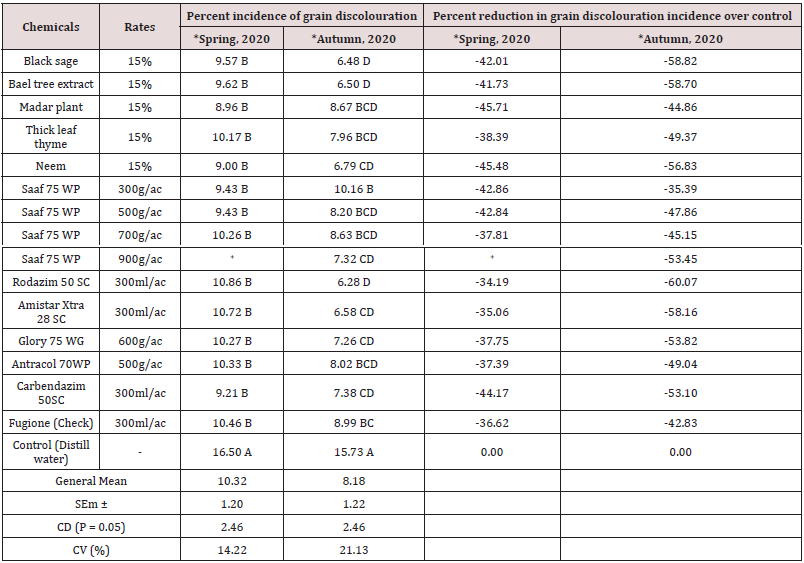
* = average of four replication; += No evaluation was done.
Means values in columns followed by same letter(s) are not differ significantly at 95% confidence interval according to Fisher’s Least Significant Difference (LSD) procedure.
Efficacy of plant extracts and fungicides against grain discolouration incidence-2021
This experiment was repeated over the two cropping seasons of 2021. Similarly, during the spring crop, 2021 all treatment showed significantly lower percent incidence of grain discolouration as compared to the untreated control (Table 2, Figure 1). Treatments with plant extract at 15 % concentration viz. Bael tree extract showed 74.39% reduction in grain discolouration incidence, followed by Thick leaf thyme extract (62.18%), Neem tree extract (59.58%), Black sage plant extract (54.63%) and Madar plant (54.53%) expressed a higher reduction in GD incidence, respectively (Table 2).
Table 2: Effect of plant extracts and fungicides on the incidence of grain discolouration during spring and autumn, 2021.
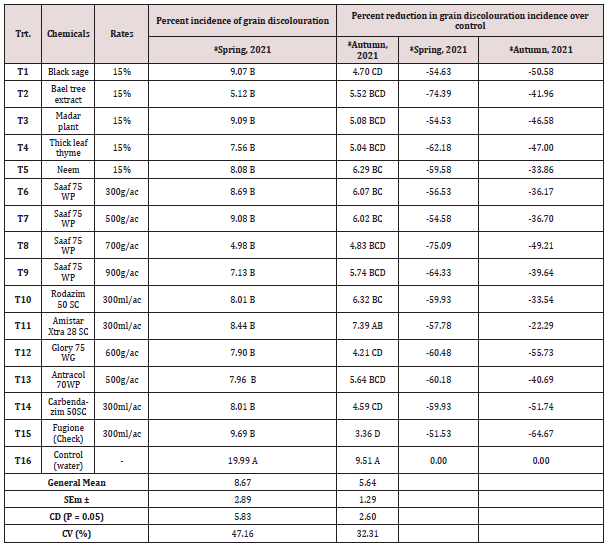
* = average of four replication;
Means values in columns followed by same letter(s) are not differ significantly at 95% confidence interval according to Fisher’s Least Significant Difference (LSD) procedure.
Efficacy of plant extracts and fungicides against grain discolouration incidence-2021
This experiment was repeated over the two cropping seasons of 2021. Similarly, during the spring crop, 2021 all treatment showed significantly lower percent incidence of grain discolouration as compared to the untreated control (Table 2, Figure 1). Treatments with plant extract at 15 % concentration viz. Bael tree extract showed 74.39% reduction in grain discolouration incidence, followed by Thick leaf thyme extract (62.18%), Neem tree extract (59.58%), Black sage plant extract (54.63%) and Madar plant (54.53%) expressed a higher reduction in GD incidence, respectively (Table 2).
Likewise, the treatments with fungicides viz. Saaf 75WP (at all rates), Rodazim 50 SC , Amistar Xtra 28 SC , Carbendazim 50 SC and Fugione (Check at 300ml/ac, respectively along with Glory 75 WG and Antracol 70WP at 600 and 500g/ac, respectively demonstrated a significant reduction in GD incidence ranging from 51.53% to 75.03% during the spring crop 2021 (Table 2, Figure 1).
Likewise, during the autumn crop 2021 all treatment application demonstrated significantly lower percent incidence of grain discolouration, with reduction in incidence of grain discolouration ranging from 22.29 to 64.67 percent over the untreated control (Table 2, Figure 1). The highest percentage incidence of grain discolouration was observed to be that of the control during both seasons (19.99% and 9.51%, respectively (Table 2).
Effect of treatments on growth and grain yield parameters – spring crop 2020
Data analysis of agronomic and grain yield parameters revealed that plants treated with Saaf at 700g/ac had significantly longer panicles (31.37cm) and there was no significant difference among other treatments with regards to this parameter (Table 3). There was however no significant difference among treatments in the number of filled grains per panicle. A significantly larger number of unfilled grains per panicle were obtained from plants treated with Neem (42), followed by Glory (37) and the control (37); while treatments with Saaf at 300ml/ac produced a significantly smaller number of unfilled grains (21) (Table 3). With regards to 1,000 grain weight per treatment, plants treated with Rodazim at 300ml/ ac was found to have among the heaviest grains (27.30g) along with Saaf at 700g/ac (27.37g), Glory (27.13g), Carbendazim (27.23g) and the control (26.90g). Plant height ranged from 101.3 in the untreated control to 96.23 in treatment with Saaf at 300g/ac. No significant difference was observed among other treatments with regards to plant height. The untreated control was also observed to have recorded a significantly larger number of tillers/m2 (392) along with Saaf at 300g/ac (396) as compared to other treatments. Other treatments to have a larger number of tillers were Amistar Xtra at 300ml/ac (384), Saaf at 500 and 700g/ac (388) and Carbendazim (384), while treatments with the botanical “Madar” produced the least number of tillers (320) (Table 3).
Table 3: Effect of plant extracts and fungicides on growth parameter, yield parameter and yield during spring 2020.
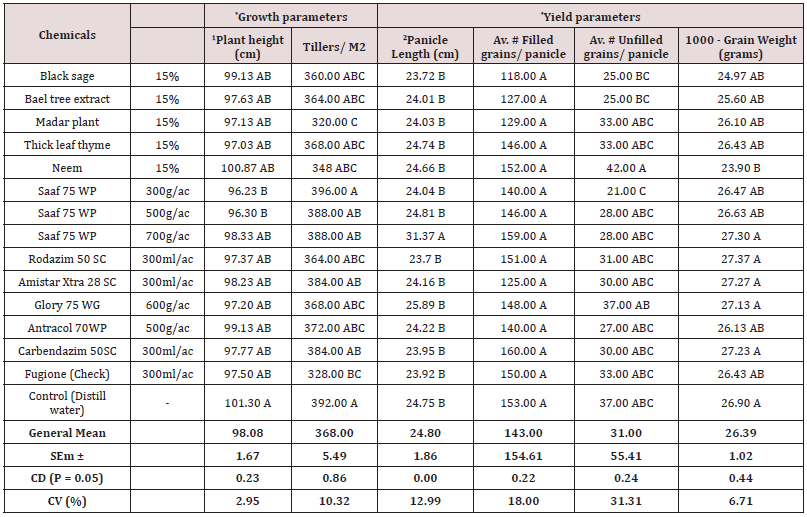
* = average of four replication; 1= Average from ten plants per each replication; 2=Average from ten panicle per each replication.
Means values in columns followed by same letter(s) are not differ significantly at 95% confidence interval according to Fisher’s Least Significant Difference (LSD) procedure.
Effect of treatments on growth and yield parameters – Autumn crop 2020
During the second crop of 2020 results indicated that both chemical fungicides and some botanicals would have produced plants with yield and parameters significantly greater than others under evaluation. The average panicle length was recorded as 28.73cm with the longest panicles coming from plants treated with Rodazim (34.58cm), followed by Saaf at 900g/ac (33.51cm) and Antracol (28.70cm); while treatment with Saaf at 300g/ac produced the shortest panicles (27.16cm) (Table 4). With regards to filled grains per panicle both treatment with botanicals plant extracts viz. Black sage extract, Neem extract (128, 124, grains per panicle, respectively) and fungicides viz. Saaf at 500g/ac and Amistar Xtra (124, 124 grains per panicle, respectively) recorded significantly larger number of filled grains per panicle. These treatments did not express no significant differences compared to the untreated control (Table 4). Other treatments which produced a larger number of grains per panicle were Saaf at 700g/ac (123), Antracol (122) and Madar extract (120) (Table 4).
Table 4: Effect of plant extracts and fungicides on growth parameter, yield parameter and yield during Autumn 2020.
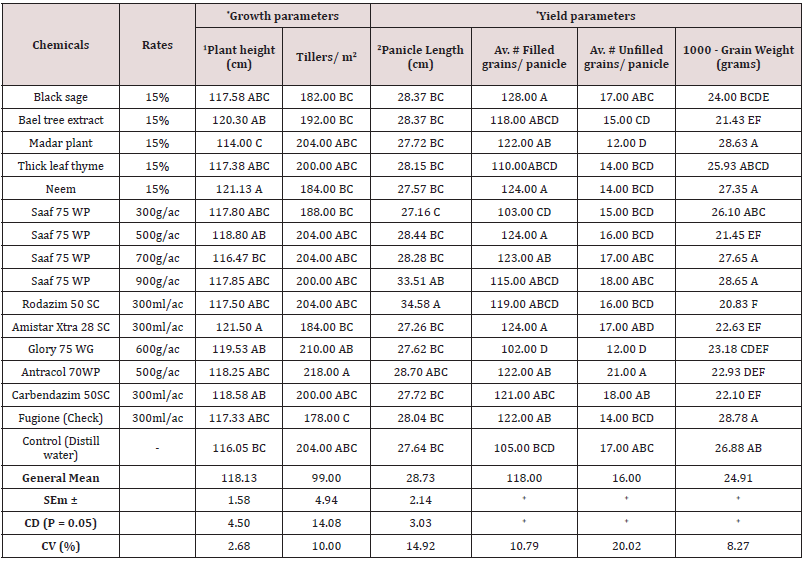
* = average of four replication; 1= Average from ten plants per each replication; 2=Average from ten panicle per each replication; += SEm ± and CD Varies.
Means values in columns followed by same letter(s) are not differ significantly at 95% confidence interval according to Fisher’s Least Significant Difference (LSD) procedures
On the other hand, treatments with Glory and black Sage at 300g/ac produced the least number of filled grains per panicle (102 and 103, respectively). The least number of unfilled grains per panicle was also recorded from both plant extract (Madar) and fungicide (Glory), both produced an average of 12 unfilled grains per panicle which was significantly lower than all other treatments (Table 4). Treatments with Antracol and Carbendazim however resulted in panicles with the largest number of unfilled grains (21 and 18 grains per panicle, respectively) (Table 4). The average weight of 1,000 grains was also recorded and treatments with Fugi One, Saaf at 700 and 900g/ac, Neem and Madar extract all produced on average significantly heavier grains (28.78, 27.65, 28.65, 28.63, 27.35g, respectively) as compared to other treatments evaluated. Treatments with Rodazim, Carbendazim, Amistar Xtra, Saaf at 500g/ac and Bael extract produced significantly lighter grains (20.83, 22.00, 22.63, 21.45 and 21.43g, respectively when compared to the other treatments (Table 4).
*= average of four replication; 1= Average from ten plants per each replications; 2=Average from ten panicle per each replications.
Means values in columns followed by same letter(s) are not differ significantly at 95% confidence interval according to Fisher’s Least Significant Difference (LSD) procedure.
The average plant height ranged from 121.52 in plants treated with Amistar Xtra to 114cm in plants treated with Madar extract. Treatment with Neem and Bael extract Saaf at 500g/ac, Carbendazim and Glory all produced plants with heights towards the higher end of the spectrum (121.13, 120.30, 118.80, 118.58, 119.53 cm, respectively) (Table 4). With regards to the number of tiller/m2, treatments with Antracol recorded the most (218), however there were other treatments which produced larger number of tillers/m2, these were viz. Glory (210), Madar extract, Saaf at 500, and 700g/ ac, Rodazim, Control (204 each), Thyme extract (200), Carbendazim (200) and Saaf 900g/ac (200). Treatment with Fugi One was observed to have produced the least number of tillers/m2 (178) (Table 4).
Table 4A: Effect of plant extracts and fungicides on growth parameter, yield parameter and yield during Autumn 2020.
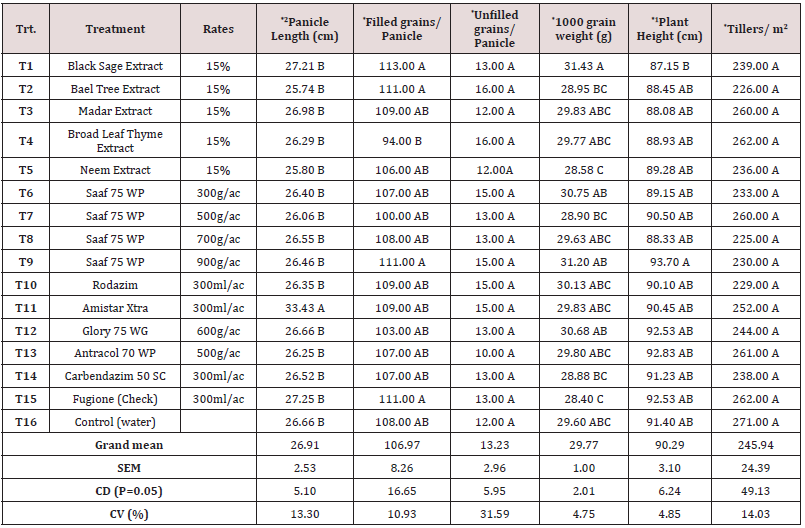
Effect of treatments on growth and grain yield parameters – Spring crop 2021
Data analysis of agronomic and grain yield parameters revealed that plants treated with Amistar Xtra at 300ml/ac recorded significantly longest panicle. No significant difference was observed among panicles of any other treatment (Table 5). Similarly, the differences in filled and unfilled grains per panicle among treatments varied little. With regards to the number of filled grains per panicle, treatments with Saaf at 900g/ac, Bael tree extract and Fugi One were observed to have the largest number of grains per panicle (111.00 each); while treatment with the Broad Leaf Thyme extract produced the least number of grains per panicle (94.00). However, no significant difference was observed among other treatments (Table 5).
Means values in columns followed by same letter(s) are not differ significantly at 95% confidence interval according to Fisher’s Least Significant Difference (LSD) procedure.
No significant difference was observed among the number of unfilled grains per panicle (Table 5). The tallest plants were found to be those treated with Saaf at 900g/ac (93.70cm), while the shortest were those treated with Sage extract (87.15cm). No significant difference was observed among the plant height of other treatments nor was any significant difference observed among treatments for the number of tillers/m2 (Table 5). With regards to 1,000 grain weight per treatment, plants treated with Black Sage Extract (15%) was found to have among the heaviest grains (31.43g ), along with Saaf at 900g/ac (31.20g); Saaf at 300g/ac (30.75g), Glory (30.68g), and Rodazim (30.13g). All other treatment including the control recorded 1,000 grain weight ranging from 28.58g to 29.95g (Table 5).
*= average of four replication; 1= Average from ten plants per each replications; 2=Average from ten panicle per each replications.
Means values in columns followed by same letter(s) are not differ significantly at 95% confidence interval according to Fisher’s Least Significant Difference (LSD) procedure.
Effect of treatments on growth and grain yield parameters – Autumn crop 2021
During the second crop of 2021 evaluation panicle length ranged from 28.53cm in treatments with Saaf at 300g/ac, followed by 28.44cm in treatments with Carbendazim to 26.83cm in treatments with Antracol (Table 6). The largest number of filled grains per panicle came from plants treated with Saaf at 300g/ac (146.00 grains), followed by those treated with Glory (145.00 grains) and Neem extract (140.00 grains). On the lower side of the spectrum were plants treated with Madar and Black Sage extracts (124.00 and 121.00 grains, respectively) as well as those treated with Antracol and Fugi One (check) (119 .00 and 113.00 grains, respectively). Although having among the highest number of filled grains per panicle, treatments with Glory also had the largest number of unfilled grains per panicle (30.00 grains), followed by treatments with Amistar Xtra (29.00 grains). Treatments with Saaf at 900g/ac was recorded as having the least number of unfilled grains per panicle (16.00 grains), followed by treatments with Madar, Bael and Saaf at 300g/ac (17.00, 18.00 and ,18.00 grains, respectively). While plants treated with some fungicides and botanicals produced large number of filled grains per panicle, the heaviest 1,000 grain weight was observed to have come from the untreated control which recorded 29.30g, followed by treatments with Carbendazim (28.93g) and Saaf at 300g/ac (28.73g). Treatments with Amistar Xtra and Glory weighed the least (27.30g and 27.13g, respectively) (Table 6).
No significant difference was observed among the heights of plants within this trial; however plots treated with Bael tree extract produced the largest number of tillers/m2(276.00), followed by treatments with Glory (268.00) and Amistar Xtra (264.00). Treatments with Broad leaf thyme, Sage and Madar extract produced the least number of tillers/m2 (187.00, 185.00 and 172.00 tillers/m2, respectively) (Table 6).
* = average of four replication; 1= Average from ten plants per each replication; 2=Average from ten panicle per each replication
Means values in columns followed by same letter(s) are not differ significantly at 95% confidence interval according to Fisher’s Least Significant Difference (LSD) procedure.
Effect of treatments on grain yield during 1st and 2nd Crop 2020
An evaluation of the grain yield during the spring of 2020 indicated treatments with Saaf at 700g/ac yielded significantly higher yields (6417.10kg/ha) as compared to other treatments, followed by treatments with Glory 600g/ac and Saaf at 300g/ac which yielded 5736.10 and 5644.20kg/ha, respectively (Table 7).
Table 7: Effects of plant extract and fungicides against grain discolouration on grain yield during 1st and 2nd Crop 2020.

* = average of four replication
Means values in columns followed by same letter(s) are not differ significantly at 95% confidence interval according to Fisher’s Least Significant Difference (LSD) procedures.
However, during the autumn crop of 2020, treatments with Rodazim, Fugi One and the untreated control recorded higher yield as compared to other treatments (5267.60, 5244.60 and 5143.90kg/ ha, respectively); while treatment with Saaf at 300g/ac yielded the least; 4297.00kg/ha. There was no significant difference among the yield of other treatments evaluated (Table 7).
Effect of treatments on grain yield during 1st and 2nd Crop 2021
An evaluation of the grain yield during the spring of 2021 indicated plot yield was highest in those treated with Saaf at 300 and 700g/ac (5672.80 and 5508.00 kg/ha, respectively), yield which were significantly lower were Madar extract (4592.8.00 kg/ha), Saaf at 500g/ac (4586.70 kg/ha) and Glory at 600g/ac (4074.8.00kg/ ha) (Table 8). Likewise, plots treated with the fungicide Amistar Xtra gave the highest total grain yield as compared to other treatments (4899.40 kg/ha). This was followed by treatment with Neem extract (4491.70kg/ha), the untreated control (4284.90kg/ha) and Rodazim (3989.70kg/ha). Bael tree extract and Antracol yielded during this trial (3383.30kg/ha and 3318.10kg/ha respectively) (Table 8).
Table 8: Effects of plant extract and fungicides against grain discolouration on yield during spring and autumn crop 2021.
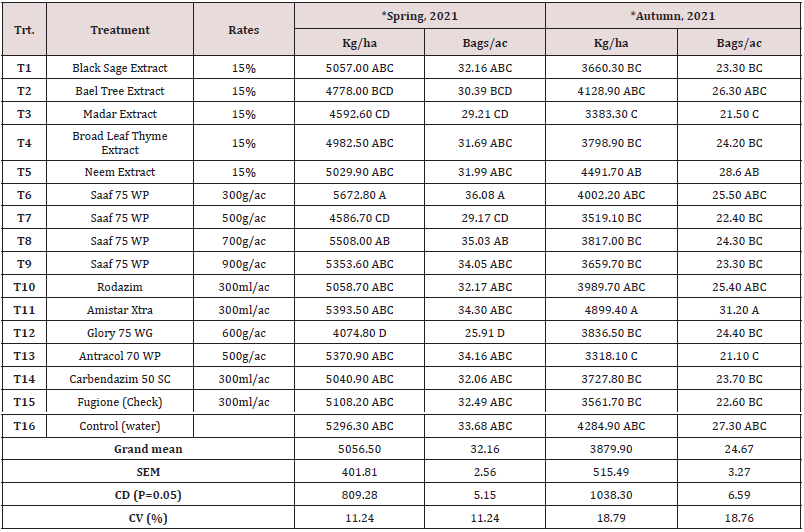
* = average of four replication
Means values in columns followed by same letter(s) are not differ significantly at 95% confidence interval according to Fisher’s Least Significant Difference (LSD) procedures.
Means values in columns followed by same letter(s) are not differ significantly at 95% confidence interval according to Fisher’s Least Significant Difference (LSD) procedures.
Notes (Figure 2 and 3): T1- Black sage (15%); T2- Bale tree (15%); T3- Madar plant (15%); T4- Thick leaf thyme (15%); T5- Neem (15%); T6- Saaf 75 WP (300 g/ac.); T7- Saaf 75 WP (500 g/ac.); T8- Saaf 75 WP (7000 g/ac.); T9- Saaf 75 WP (900 g/ac.); T10- Rodazim 50 SC (300 g/ac.); T11- Amistar Xtra 28 SC (300 g/ ac.); T12- Glory 75 WG (600 g/ac.); T13- Antracol 70WP(500g/ac); T14- Carbendazim 50 SC (300 g/ac.); T15- Fugi-One (Check (300 ml/ac.); T16- Untreated control.
Figure 2: Percentage increase or decrease in grain yield over the untreated control (T16) Spring and Autumn 2020.

Figure 3: Percentage increase or decrease in mean grain yield over the untreated control (T16) spring and autumn 2021.

Figure 3. Percentage increase or decrease in mean grain yield over the untreated control (T16) spring and autumn 2021.
In general, all medicinal plant extracts and fungicidal treatment evaluated recorded significantly lower percent grain discolouration incidence as compared to the untreated control (Table 1 and 2, Figure 1). Out of which these treatment viz. Black sage (15%), Bale tree (15%); Madar plant (15%); Thick leaf thyme (15%); Neem (15%); Saaf 75 WP (300 g/ac.); Saaf 75 WP (500 g/ac.); Saaf 75 WP (7000 g/ac.); Saaf 75 WP (900 g/ac.); Rodazim 50 SC (300 ml/ac.); Glory 75 WG (600 g/ac.); Antracol 70 WP (500g/ac); Carbendazim 50 SC (300 g/ac.) and the positive check treatment Fugi-One at 300 ml/ac., showed reduction in the incidence of grain discolouration ranging from 33.54 to 75.06 percent over the four seasons in 2020 and 2021 as compared to the untreated control (Table 1,2 and Figure 1). Most of these treatments also showed positive influence in terms of growth parameters, yield parameters and grain yield as compared to the untreated control (Table 3-8, Figure 2 and 3) and therefore can be recommended for uses against the gain discolouration condition.
Discussion
Rice grain discoloration condition is becoming a serious threat to rice crop result in the lowering of the quality and quantity of rice being produced [7,9]. evaluated 12 aqueous plant extracts against seed born fungal pathogen associated with brinjal seeds, Solanum melongena L. and reported that all plant extracts significantly inhibited the tested fungi associated with brinjal seeds. These researchers also reported that the aqueous leaf extracts of Azadirachta indica and Calotropic procera significantly inhibit the growth of some seed borne fungi viz. Phomopsis vexans, Fusarium oxysporum, Aspergillus flavus, Aspergillus nigar, Curvularia lunata, Penicillium spp., with 4% and 5.3% seed infection as compared to the control with 66% seed infection and also enhanced the seed germination of brinjal seeds. Also [8], studied several plant extracts, fungicides and bio-agents against rice GD condition and reported that spraying of neem oil 80EC (3%) at flowering stage and ten days later reduced the grain discolouration from 21.60 to 11.45 per cent which was on par with carbendazim (250 g ha-1) and also demonstrated significant increase in the grain yield compared to untreated control. Likewise in this present experiment similar findings were demonstrated when aqueous plant extracts of Black sage plant (Cordia curassavica) at 15% concentration, Bale tree (Aegle marmelos) at 15%; Madar plant (Calotropis gigantea, C. procera) at 15%; Thick leaf thyme(Thymus vulgaris) at 15% and Neem (Azadirachta indica) at 15% concentration, respectively were applied against the grain discolouration pathogens under field condition during first and second crop of 2020 and 2021 under Guyana condition. In alike manner, many other researchers around the world have evaluated many different fungicides for the control of the GD condition [7,10,11]. conducted similar study to this present research using four fungicides viz. Dithane M-45, Ridomil, Topsin-M and Carbendazim for the control of pathogens on with grain discolouration pathogens. The researcher reported that Dithane and Ridomil showed best control over mycelial growth of all isolated pathogens except F. moniliforme where Carbendazim was found the best followed by Topsin M, Dithane M-45 and Ridomil respectively. The researchers also reported that with the grain discoloration pathogen treated with both of these fungicides showed maximum germination and least seedling mortality. Likewise [11]. reported that treatment two foliar spray with Azoxystrobin 23SC (0.1%) performed better with lowest per cent incidence of grain discoloration and higher grain yields when the treatment was applied. Also [12], found carbendazim+mancozeb to give superior control over rest of the fungicides against discoloured rice grain and all other grain and yield attributes. Similarly, the results of these researchers were in agreement with the present research finding of this experiment where fungicides Saaf 75 WP (300 g/ac.); Rodazim 50 SC (300 ml/ ac.); Glory 75 WG (600 g/ac.); Antracol 70 WP (500g/ac); Carbendazim 50 SC (300 g/ac.) and the positive check treatment Fugi-One at 300 ml/ac., showed higher reduction in the incidence of grain discolouration ranging from 33.54 to 75.06 percent over the four seasons in 2020 and 2021 as compared to the untreated control. Likewise, most of these treatments also showed positive influence in terms of growth parameters, yield parameters and grain yield as compared to the untreated control and therefore can be recommended for uses against as control of the gain discolouration condition. Additionally, the findings of this present study agreed fully with the results of [4]. When few of the same fungicides (Amistar Xtra 28 SC (Triazol, Estrobilurtina, Cyproconazol, Azoxystrobin) 1.5 mL L-1; Glory 75 WG (Mancozeb+Azoxystrobin) at 3.0 g L-1; Antracol 70WP (Propineb) at 5.0 g L-1; and Carbendazim 50SC (Carbendazim 50%) at 1.5 mL L-1) were evaluated against the grain discolouration condition. The researchers demonstrated and confirmed that these four fungicides demonstrated more than 50% reduction in the incidence of grain discolouration and reported greater number of filled grains, 1000 grain weight and grain yield compared to control.
Conclusion
It can be concluded from the research that these treatments with Black sage (15%), Bale tree (15%); Madar plant (15%); Thick leaf thyme (15%); Neem (15%); Saaf 75 WP (300-500 g/ac; Rodazim 50 SC (300 ml/ac.); Glory 75 WG (600 g/ac.); Antracol 70 WP (500g/ac); Carbendazim 50 SC (300 g/ac.) and Fugi-One at 300 ml/ac. demonstrated significant reduction in grain discolouration incidence and favorable influence in terms of plant growth, yield parameters and grain yield responses and therefore can be recommended as a protective treatment used for managing the grain discolouration conditions.
Author’s Contributions
First author Rajendra Persaud design and carried out the experiments, analyzed the data and wrote the manuscript. All other authors provide technical advice, assisted with editing, moral support, read agree with the content of the manuscript.
Acknowledgement
The authors are thankful to Guyana Rice Development Board (GRDB) for providing them with the necessary funding and laboratory facility to conduct this research work at the GRDB, Rice Research Station, Burma in Guyana. Also thankful for assistance received from staffs of the department of Plant Pathology who assisted in one way or another with the conduct of these experiments.
Disclosure Statement
There is no potential conflict of interest to declare.
References
- Persaud M, McGowan D, Gobind N, Persaud R, Corredor E (2021) Evaluation of Yield and Yield Attributing Traits in Advanced Breeding Lines of Rice (Oryza sativa L.) over Two Rice Growing Seasons in Guyana. Greener Journal of Plant Breeding and Crop Science 9(1): 17-23.
- GRDB (Guyana Rice Development Board) (2022) Draft Technical Annual report. GRDB, Georgetown
- Islam W, Ahmed M (2017). Identification of different fungi associated with grain discolouration complex disease of rice and management of infested grains through fungicides. Int J Sci Res Agric Sci 4(2): 30-35.
- Persaud R, Persaud M, Saravanakumar D, Homenauth O (2019) Identification of causal agent and management of grain discoloration in rice. Journal of Plant Diseases and Protection (2): 183-196.
- GRDB (Guyana Rice Development Board). 2021. Annual report. GRDB, Georgetown
- Baite MS, Raghu S, Prabhukarthikeyan SR, U Keerthana, Nitiprasad N Jambhulkar et al. (2020) Disease incidence and yield loss in rice due to grain discolouration. J Plant Dis Prot (127): 9-13.
- Arshad HMI, Khan JA, Naz S, Khan SN, Akram M (2009) Grain discoloration disease complex: A new threat for rice crop and its management. Pakistan Journal of Phytopathology 21(1): 31-36.
- Akila R, Ebenezar EG (2009) Ecofriendly approaches for the management of grain discolouration in rice. J. Biol. Control 23(2): 175-180.
- Kuri SK, Islam RM, Mondal U (2011) Antifungal potentiality of some botanical extracts against important seedbornd fungal pathogen associated with brinjal seeds, Solanum melongena L. Journal of Agricultural Technology 7(4): 1139-1153.
- Rini P, Dipankar M (2021) Chemical Management of Grain Discolouration Disease of Rice. Pesticide Research Journal 33(1): 25-29.
- Jayasekhar M, Kavitha K (2020) Management of Sheath Rot and Grain Discolouration of Rice (Oryzae sativa L.). Int.J. Curr. Microbiol. App. Sci 9(4): 309-320.
- Gajre NK, Chauhan HL (2018) Management of rice grain discolouration disease by chemical and biological means. Trends in Biosciences 11(10): 2045-2049.
- Devi Oinam Jitendiya, Chhetry GKN (2013) Evaluation of Antifungal Properties of Certain Plants against Drechslera oryzae causing Brown Leaf Spot of Rice in Manipur Valley. International Journal of Scientific and Research Publications 3(5): 1-3.
- Chandramani R ( 2007) Studies on grain discolouration of rice. Master’s thesis. The Indira Ghandhi Agricultural University, Raipur.
- (1996) ISTA (International Seed Testing Association) International rules for seed testing. ISTA Zurich.
- Ora N, Faruq AN, Islam MT, Akhtar N, Rahman MM (2011) Detection and identification of seed borne pathogens from some cultivated hybrid rice varieties in Bangladesh. Middle-East J Sci Res 10(4): 482–488.

Top Editors
-

Mark E Smith
Bio chemistry
University of Texas Medical Branch, USA -

Lawrence A Presley
Department of Criminal Justice
Liberty University, USA -

Thomas W Miller
Department of Psychiatry
University of Kentucky, USA -

Gjumrakch Aliev
Department of Medicine
Gally International Biomedical Research & Consulting LLC, USA -

Christopher Bryant
Department of Urbanisation and Agricultural
Montreal university, USA -

Robert William Frare
Oral & Maxillofacial Pathology
New York University, USA -

Rudolph Modesto Navari
Gastroenterology and Hepatology
University of Alabama, UK -

Andrew Hague
Department of Medicine
Universities of Bradford, UK -

George Gregory Buttigieg
Maltese College of Obstetrics and Gynaecology, Europe -

Chen-Hsiung Yeh
Oncology
Circulogene Theranostics, England -
.png)
Emilio Bucio-Carrillo
Radiation Chemistry
National University of Mexico, USA -
.jpg)
Casey J Grenier
Analytical Chemistry
Wentworth Institute of Technology, USA -
Hany Atalah
Minimally Invasive Surgery
Mercer University school of Medicine, USA -

Abu-Hussein Muhamad
Pediatric Dentistry
University of Athens , Greece

The annual scholar awards from Lupine Publishers honor a selected number Read More...





